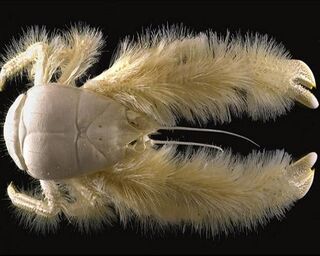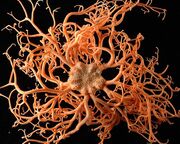In all the time that humankind has been scientifically categorizing life, we've managed to get slightly fewer than 2 million species cataloged. About 46 new species were discovered every day in 2006, according to researchers at Arizona State University's International Institute for Species Exploration. Some scientists say that Earth could hold as many as 100 million different species, so we still have our work cut out for us. Most new species are small invertebrates that would be overlooked by anyone other than a scientist; however, every now and then we stumble across a new monkey, large lizard or some other incredible animal that we've never seen before. Here are ten amazing newly discovered species. The article gets better the closer you get to ten!
1.) The Yeti Crab[]
Identification:

The Yeti Crab
The yeti crab was discovered in March 2005 by a group organized by Robert Vrijenhoek of the Monterey Bay Aquarium Research Institute in Monterey, California and Michel Segonzac of the Ifremer and a Census of Marine Life scientist using the submarine DSV Alvin, operating from RV Atlantis. The discovery was announced on 7 March 2006. It was found along the Pacific-Antarctic Ridge, 1,500 kilometres (930 mi) south of Easter Island at a depth of 2,200 metres (7,200 ft), living on hydrothermal vents. Based on both morphology and molecular data, the organism was deemed to form a new biological family (Kiwaidae); a second species, Kiwa puravida, was discovered in 2006 and described in 2011.
Characteristic:[]
The animal has strongly reduced eyes that lack pigment, and is thought to be blind. The "hairy" pincers contain filamentous bacteria, which the creature may use to detoxify poisonous minerals from the water emitted by the hydrothermal vents where it lives. This process is known as chemosynthesis. Alternatively, it may feed on bacteria, although it is generally thought to be a carnivore.
Although it is often referred to as the "furry lobster" outside the scientific literature, Kiwa hirsuta is a squat lobster, more closely related to crabs and hermit crabs than true lobsters. The term "furry lobster" is more commonly used for the family Synaxidae.
2.) The Caqueta Cat Monkey[]

The Calueta Monkey
Discovering a new mammal is a relatively rare occurrence; discovering a new primate is rarer still. In 2010, a team of scientists ventured into the Amazon jungle in southern Colombia and documented, for the first time, the Caqueta titi monkey, an adorable, tiny primate notable for being one of the few monogamous monkeys and for purring like a cat. Primatologist Thomas Defler led his team to the Colombia's Caqueta province, which was too dangerous (because of gang activity) to visit just a few years ago. Sadly, just as we're discovering the Caqueta titi monkey, we're considering listing it as an endangered species. It's estimated that there are fewer than 250 living in the wild.
The Caqueta Monkey (Callicebus caquetensis), also known as the red-bearded titi or the bushy-bearded titi, is a species of titi monkey endemic to Colombia found in the Department of Caquetá region. Taxonomically, it is a member of the Callicebus cupreus group, following Shunsuke Kobayashi's Callicebus grouping. It was first described by Thomas Defler, Marta Bueno and Javier Garcia in 2010. It is highly endangered due to habitat fragmentation and a small population. Its fur is generally brown, with a lighter tail and chestnut-red undersides, neck and cheeks. It is similar in appearance to the ornate titi and white-tailed titi except that it does not have a white forehead bar, nor does it have the white hands and feet of the ornate titi. It also has a red beard. It has 22 chromosome pairs (not counting the sex chromosomes), with a diploid chromosome number of 2n=46.
In the paper describing the species, the authors recommend that the species be classified as critically endangered by the International Union for Conservation of Nature (IUCN). According to the authors' estimate, the population size of the species may be fewer than 250 adult animals.It lives in forests fragmented by agricultural activity, and dispersal is hazardous since it must cross open savanna or barbed wire in order to reach new nearby forest fragments. The species has a geographic range of just about 100 square kilometers (39 sq mi) and actually occupies only about 10 square kilometers (3.9 sq mi) within that range.
3.) Gorgon head starfish[]

The gorgon head starfish, or the basket star, is a cousin to the starfish and is well named — its arms split off its body like alien tentacles. The gorgon head starfish was discovered by scientists from Scotland's University of Aberdeen while they were studying marine life along the Mid-Atlantic Ridge. It was caught a half mile down and eats plankton and shrimp.
Gorgon Head Starfish (Euryalid Ophiuroid-Gorgonocephalus sp.), was caught at approximately 800m below sea level in the Atlantic Ocean. Samples of this rare animal were collected on the six-week voyage aboard the research ship James Cook. Details of the trip were revealed by scientists at the University of Aberdeen, who are leading the UK contribution to the project exploring marine life along the Mid-Atlantic Ridge between Iceland and the Azores
4.) Blossom Bat[]

The blossom bat, or Syconycteris sp nov, was found in the Foja mountains on the Indonesian island part of New Guinea by a scientific expedition funded by the National Geographic Society,
the Smithsonian Institution and the Indonesian Institute of Sciences. It's been called the "hummingbird of the bat world" because it uses its long tongue to drink nectar from trees.
5.) The Sneezing Monkey of Burma []

The Sneezing Monkey of Burma
The sneezing monkey of Burma is another member of the Newly Discovered, Already Endangered Club. Some experts estimate that only 300 are left in the wild in the Maw River region, their numbers declining due to hunting and habitat loss. Chinese traders have been active in the area, feeding the black market demand for monkeys and other rain forest wildlife. These monkeys are known to go into long sneezing fits when it rains because their upturned noses allow water to enter their sinuses.
Although the monkey was known to the local Inhabitants for thousands of years, it was not discovered until 2011. The species is known in local dialects of Lisu people as mey nwoah and Law Waw people as myuk na tok te, both of which mean "monkey with an upturned face". Rain allegedly causes it to sneeze due to the short upturned nasal flesh around its nostrils. People from the area report that it sits with its head directed downwards, hiding its face between its knees when it rains.
6.) The Indonesian Rhino Frog[]

Indonesian Rhino Frog
Those who have been there call it a lost world and the closest thing on Earth to the Garden of Eden. Undisturbed for thousands of years, the mist-shrouded Foja mountains of Indonesian New Guinea offer a vision of a planet without human influence. Dripping with life, the pristine forested slopes harbor a bewitching display of spectacular species, many of which are new to science.
The Pinocchio-nosed frog was discovered recently during a wildlife expedition to Indonesia’s remote Foja Mountains. This long-nosed frog, a tree frog, has a spike on its nose that point upward when the male is calling but deflates and points downward when he is less active.
_OM BHOWMICK
7.) The Indonesian Frogfish[]

The Indonesian frogfish lives in the ocean near Bali and Indonesia and was discovered in 1999. It's a small creature, growing to just 6 inches long, and is unique among fish because of its flat face, which gives it the same depth perception as humans. The fish's skin, which is a swirling pattern of yellow, white and dark orange,
The Indonesian frogfish's skin is also as unique to each fish as our fingerprints are to us. It's endemic to Ambon island and spends most of its time in shallow waters close to shore.
8.) The Smallest Species in the Kangaroo Family[]

The Foja mountains, located in the Indonesian province of Papua on the island of New Guinea, cover an area of more than 300,000 square hectares of unroaded, undeveloped and undisturbed rainforest. The region is recognized by scientists as a productive species generator because of its relative isolation, elevation and tropical environment.
These mountains are a virtual island where species have evolved for millennia. One of the discoveries proved a record-breaker: a new species of dwarf wallaby (Dorcopsulus sp. nov.) is now the smallest in the world.
9.) Tiny Indonesian Creature[]

This creature was generously described as "pea-sized" when Conservation International announced, in August 2010, the Microhyla nepenthicola's discovery in a pitcher plant on the Indonesian part of Borneo, an island in Southeast Asia. At first, scientists assumed they were looking at young species, but soon concluded that even the largest of the adult males fail to reach more than half an inch in length. Now, they describe it as the tiniest amphibian known to inhabit the Old World (Europe, Asia and Africa).
10.) Sea Pigs[]

A Sea Pig
Last but not least, Sea Pigs! While sea pigs may be common in the icy waters of the Southern Ocean, they are utterly unfamiliar to us. British Antarctic Survey scientists who observed them say they are among the most common sea creatures lurking in the depths off Antarctica – something like an underwater hog farm.
